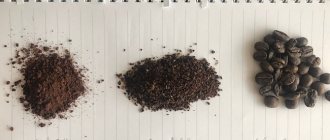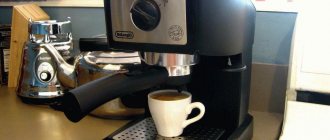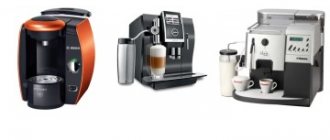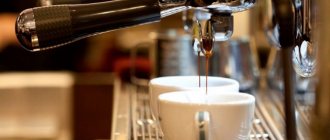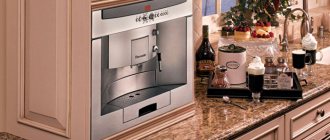Centuries passed, and the popularity of coffee only increased. It was successfully brewed in the royal chambers, khan's palaces and in the neighborhoods of the poor. To prepare an invigorating drink, masters successfully used:
- Openwork French coffee pots;
-Turkish cezves;
-Ordinary metal buckets.
Despite the huge variety of recipes, the essence of the process remained the same - cooking took place over an open fire or heated sand. The history of the modern coffee machine is as follows:
The first coffee machine in the world
The laurels of the first inventor of a similar coffee machine belong to Louis-Bernard Babot. The Frenchman realized that the fastest way to brew the drink was when a steam-water mixture passed through a portion of ground coffee. Both the speed of its preparation and volumes increased. However, the inventor was unable to create a fully functional device suitable for commercial use.
Another representative of France, Edward Loisel de Santé, had to work on improving this development. The appearance of the original steam coffee maker, called the “Leusel hydrostatic vase,” dates back to 1843. Her debut appearance occurred in 1855. The main advantage of this device was its decent productivity - 2000 cups of drink per hour. The design had many shortcomings. This is about:
-Increased sizes;
- Constant burning of coffee beans;
-Insufficient pressure in the apparatus (no more than 1.5÷2 atm.).
An attempt to forcibly increase the pressure ended in an explosion.
The next step towards modernizing the coffee machine was taken by representatives of Italy. After decades of fruitless experiments, Luigi Bezzera managed to obtain a patent for the modernized device. Its key difference from its French predecessor was the principle of operation. The effect of steam and water on the coffee mixture was combined, and increased pressure in the container was created due to the action of a directed steam jet.
The most important advantages of this invention should be considered:
-Accelerated cooking (the process lasted a few seconds);
-The strength of the drink and its excellent aroma.
The espresso culture owes to Luigi Bezzera and another innovation - the use of a coffee machine to froth milk.
Coffee machines
Over time, having acquired a number of automated functions, the espresso coffee maker turned into a coffee machine. Now the entire process of making the drink (from grinding the beans to filling the cup with ready-made coffee) is taken over by the device. The only thing required of a person is to press a button. Depending on the degree of automation, coffee machines are divided into three categories: carob, combined and automatic.
Carob coffee machine
Carob coffee machines are designed for making espresso. The most important advantage of this type of coffee machine is the simplicity of the device and the relatively low price. Coffee obtained in this way boasts excellent quality and a pronounced aroma.
This type of coffee machine uses finely ground beans. It should be noted that the strength of the coffee is not programmatically regulated in any way, but depends on the degree of compaction of the coffee in the cone and the quality of the grinding - the finer the grinding, the stronger the coffee.
COFFEE MACHINE
Philips Saeco HD8327/99
RUB 17,990
Citylink
Espresso combine
Combination coffee machines or espresso combines combine a carob coffee maker and a coffee grinder to provide the required grind quality. Such models are significantly more expensive, however, grinding directly (add: before brewing) greatly affects the final quality of the drink.
Espresso processors can use both ground and bean coffee without any additional equipment.
COFFEE MACHINE
DeLonghi ESAM 2600 1.8 l
RUB 22,990
Techport
When did the first coffee machine appear?
The serial production of devices was started by another Italian - Desidero Pavoni. The entrepreneur, who was interested in commercial success, managed to found a whole). The first device to come off the assembly line was equipped, in addition to traditional components:
-Piston pump;
-Valve for releasing steam and spilling water.
Coffee lovers should also be grateful to Pavoni for the “correct” espresso recipe. Empirically, the inventor found that to obtain an excellent drink, constant pressure (9 Bar) is required, as well as maintaining a certain temperature (86÷92 ºC).
The technology for creating espresso developed rapidly throughout the first half of the last century. At that moment the world saw the models:
"Rancilio La Regina" (1927)
The coffee machine, created by Roberto Rancilio, quickly came into use in numerous cafes. The operating principle underlying the functioning of this apparatus was completely borrowed from Pavoni’s invention. This device was distinguished by its elegant Belle-Epoque design, which was appreciated by restaurateurs and their clients.
"Illetta" (1935)
Francesco Illy should be proud of the creation of this model. His invention was equipped with a water spill function and for a long time established the recipe for the best Italian espresso, when 40 ml of water contains 7 g of ground coffee. This device differed from earlier devices in that water pressure, rather than steam, was supplied through the mass of ground coffee.
Despite obvious progress, equipment for commercial coffee preparation remained extremely bulky, difficult to maintain, and therefore too expensive. Only the owners of the most expensive restaurants could afford its constant operation. It should be noted that the barista serving the machine required not only skill, but also considerable physical strength. Therefore, women were not involved in the operation of this equipment.
Coffee machine by Achil Gaggia (1945)
The key feature of this new product was a special “spring-loaded” lever. Thanks to the action of this detail, the surface of high-quality espresso is decorated with its business card - the signature golden foam.
For many centuries and even millennia, coffee has been and remains one of the most popular drinks in the world. Coffee was brewed in exquisite French coffee pots, Turkish cezves and even in simple ladles. The preparation process remained unchanged - the drink was prepared over fire or hot sand.
The history of the coffee maker, like many inventions, began a long time ago. The Turks are known to have been brewing coffee as early as 575 AD. e., and the history of the coffee maker really begins there. Much of the history of the coffee maker was lost before this century, so no one knows much about the history of the coffee maker from the time of the Turks until 1818, when the first coffee percolator was created.
The Industrial Revolution in the 19th century gave us the invention of the steam engine. At this moment, the idea of creating a coffee machine that prepared coffee using steam pressure was born.
In 1843, the Frenchman Edward Loisel de Santé assembled a unique steam coffee maker, or “Loisel's hydrostatic vase,” as it came to be called in honor of the inventor. The coffee machine was presented in 1855 at an exhibition in Paris. The invention was a huge success.
The “Loisel hydrostatic vase” could brew up to two thousand cups of coffee per hour. However, the coffee machine turned out to have a lot of technical shortcomings. The coffee was burned out, and the pressure of the steam boiler turned out to be only 1.5–2 atmospheres. Increasing the pressure was fraught with an explosion of the apparatus itself.
Half a century later, in 1901, Milanese Luigi Bezzera registered a patent for the first improved steam coffee machine. Luigi wanted to shorten the brewing time so his employees wouldn't have to spend so much time on coffee breaks.
The coffee machine was called Tipo Gigante and was more compact and practical. And the operation of the device was based on the combined use of water and steam. Pressure in the coffee machine was created using a directed jet of steam.
Such concepts as holder and group appeared - now each cup of espresso was prepared using a strictly measured portion of coffee. The process of preparing coffee took a matter of seconds, and the drink itself was strong, rich and aromatic.
Luigi Bezzera introduced another innovation into the new espresso culture: from now on, the steam in the coffee machine was used not only for brewing espresso, but also for frothing milk. This was a real breakthrough.
Luigi was not given the chance to become a great businessman and over time he sold the license for the invention to Tipo Gigante for a nominal fee.
However, the right to produce coffee machines did not extend beyond Italy, since the license was bought by the successful Italian industrialist Desidero Pavoni. In 1905, Parvoni founded the company La Pavoni SPA and released the first steam coffee machine, Pavoni Ideale, intended for commercial use.
Pavoni Ideale is an improved Bezzer apparatus, which has a piston pump, as well as a special valve for releasing steam and pouring hot water.
Desidero Pavoni is considered the discoverer of the “correct” espresso - through long experiments he was able to discover that the best coffee is obtained at a temperature of 86-92 °C and a pressure of 9 bar.
Espresso technology flourished in the first half of the 20th century. It was during this period that most of the world famous companies producing coffee equipment appeared. In 1927, Italian Roberto Rancilio hand-assembles a stylish coffee machine for bars and cafes. Based on the operating principle, the model La Regina was not very different from its predecessor, but had an elegant design in the “belle-epoque” style, which was fashionable in restaurateur circles at that time. In 1935, a coffee machine with automatic water dispensing appeared. The designer of the Illetta model was Francesco Illi. Thanks to the improvement, a standard dosage for Italian espresso appears, which has remained unchanged for many decades: 7 g of ground coffee per 40 ml of water. The Illetta model had another important feature - the pressure of water passing through the ground coffee was created by compressed air, and not by steam.
All espresso machines of the first half of the 20th century were not suitable for home use and were expensive. The owner of a luxury establishment could afford such a device. And the absence of women among baristas at that time was due to the presence of good physical training - after all, a pressure of 9 bar was created due to the muscular strength of the barista who held the lever.
The times of World War II acutely affected the development of the entire industry, including the espresso industry. Fortunately for coffee lovers, in 1945 Achil Gadzhia designed another new product - a coffee machine, to which we will say “Thank you” for the lush golden foam on well-brewed espresso. The device had a “spring-loaded lever” mechanism.
Progress is constantly moving forward and lever coffee machines have been replaced by semi-automatic and automatic coffee machines. And now the pressure in the coffee machine is created by the operation of an electric pump. The Italian company Feama became the founder of the first coffee machine, which is equipped with an electric pump. The coffee machine was released in 1961 and since then the design of the classic carob coffee machine has remained virtually unchanged. Coffee equipment manufacturers continue to develop technology to improve the taste of espresso.
New models of traditional coffee machines are distinguished by modern design and technological features, such as an automatic cappuccino maker, espresso quality control or a coffee tablet pre-wetting function.
Will any of the new models be immortalized in coffee maker history? Time will show. Of course, there is always room for innovation and invention. And we will enjoy the taste and aroma of your favorite coffee drink and closely monitor the progress of the history of the development of coffee machines.
Further history of the coffee machine
The continued evolution of lever coffee machines has led to the emergence of automatic and semi-automatic models. To create the required pressure, they were equipped with a special electric pump. The first device of this type began to be produced by the Italian manufacturer Faema. From this point on, the improvement of coffee making machines practically ceased.
Both professional restaurateurs and an army of coffee lovers are completely satisfied with the quality of the brewed espresso. Although the range of devices is constantly being replenished with more and more advanced models, changes occur only in their design and a slight expansion of functionality (for example, the appearance of a cappuccino maker).
Types of coffee machines
There are several types of coffee machines. Let's look at each of them in more detail.
Steam engines
Due to their relatively primitive structure, such coffee machines are easy to use and operate. They are affordable and compact. The principle of operation of steam apparatus is as follows: in a hermetically sealed container, water is brought to a boil, steam is formed.
This creates pressure, pushing the water through the reservoir into the coffee. The operating principle of steam coffee makers has some similarities with geyser machines.
A significant disadvantage of steam coffee machines is the low pressure - 1-1.5 bar, while preparing classic espresso requires a pressure of 9 bar. And they are very difficult to clean. In addition, the water in the system practically boils.
Be sure to read: Pour over (hario) - features of the coffee brewing method
It is known that when brewing coffee it is better not to bring it to a boil, as this leads to excessive extraction of aromatic and flavor components. Consequently, the drink may turn out to be oversaturated - with a pronounced bitterness.
Lever coffee machines
Lever, that is, lever-operated devices require physical strength to prepare a drink. There are 2 types of mechanisms:
- Manual. This type is easy to recognize by the location of the lever - it is horizontal. In this case, the barista can control the flow rate, duration of pre-wetting of the beans and pressure by pressing the lever.
- Spring-loaded. The mechanism lever is located vertically. Easier to operate than a manual device.
Operating principle of a lever coffee maker
Lever coffee makers are devoid of any electronics, which can even be considered their advantage. Currently they are not very popular. And they are not suitable for coffee shops, since the coffee preparation speed is low. But for home use they are quite suitable. True, they only allow you to prepare classic espresso.
Pump coffee machines
Pump coffee machines first came into use in 1960. The presence of electrics in the device speeds up the procedure for preparing a drink and minimizes human participation in this process.
Modern pump coffee makers are divided into 3 types:
- semi-automatic;
- automatic;
- superautomatic machines.
The difference between all types is in the type of pumps, the number of boilers and electronic control. Let's look at them in more detail.
Semi-automatic
They work through an automated system for supplying water to groups. But controlling the degree of grinding of the beans, tempering, and the duration of extraction - all this falls on the shoulders of the barista. Simply put, it is responsible for espresso, and the pressure and temperature of the water are regulated by the device.
Slot machines
Unlike semi-automatic machines, such machines independently stop the water supply. This ensures that the volume of each coffee is always equal. In this case, the barista does not need to stand over the machine so as not to miss the moment of preparing the next cup of drink.
Superautomatic machines
Super-automatic espresso machines prepare the coffee themselves. The machine grinds the beans, weighs them, fills the portafilter with them and tempers them. The coffee machine will always prepare the same coffee. Some models of super-automatic machines allow you to customize the grinding size and time - a creative barista can't go wild here. Not the best option for coffee shops. But it’s quite suitable for the office and home.
